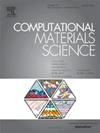Size-dependent power laws for edge dislocations in Nickel superalloys: A molecular dynamics study
IF 3.3
3区 材料科学
Q2 MATERIALS SCIENCE, MULTIDISCIPLINARY
引用次数: 0
Abstract
We present in this work computational evidence, using molecular dynamics simulations, of a size effect in the relationship between the critical resolved shear stress for edge dislocation motion in nickel superalloys and the size of precipitates, under certain conditions. We model the superalloy as periodically spaced cubic precipitates inside a uniform matrix. We then analyze the motion of paired edge dislocations in the phase when subject to an external shear stress for various volume fractions of the precipitate for a wide range of temperatures, from 300 K to 700 K. While the variation of dislocation velocity is not significant, the critical resolved shear stress is found to exhibit a power law dependence on the volume fraction of the precipitate with two distinct regimes which have similar exponent but markedly different prefactors; we also observe that this two-regime behavior remains true across a wide range of temperatures. We present a detailed analysis of this behavior and reduce it to a linear dependence of the critical resolved shear stress on the length of the precipitate along the direction of dislocation motion. We further identify the critical length scale underlying the transition between the two observed regimes as the total core width of the paired dislocations in a pure system, which includes in addition to the complex stacking fault separating the partials of the paired dislocations the width of the anti-phase boundary that is formed between the super-dislocations. We present auxillary results using spherical precipitates that exhibit the same trend, but a full analysis of the interplay between size of the precipitate, volume fraction, and other related factors is not pursued in this work. Despite the special configurations considered in this work, the results presented here highlights non-trivial size-dependent effects, provides new details on the strengthening effect of precipitates in nickel superalloys, and has important implications for larger scale dislocation dynamics studies for nickel superalloys.

镍高温合金中边缘位错的大小相关幂律:分子动力学研究
在这项工作中,我们提出了计算证据,使用分子动力学模拟,在一定条件下,镍高温合金中边缘位错运动的临界分解剪应力与γ′析出相尺寸之间的关系存在尺寸效应。我们将高温合金建模为均匀γ基体内周期性间隔的立方γ′沉淀。然后,我们分析了在300 K到700 K的广泛温度范围内,γ′析出物的不同体积分数受到外部剪切应力时γ相中成对边缘位错的运动。虽然位错速度的变化不显著,但发现临界分解剪应力与γ′析出物的体积分数呈幂律关系,具有指数相似但前因子明显不同的两种不同制度;我们还观察到,这种双态行为在很宽的温度范围内仍然成立。我们对这种行为进行了详细的分析,并将其简化为沿位错运动方向的临界分解剪切应力与γ′沉淀长度的线性依赖关系。我们进一步确定了两种观察到的过渡区之间的临界长度尺度作为纯γ′系统中成对位错的总核心宽度,除了分离成对位错部分的复杂堆积断层外,还包括在超位错之间形成的反相边界的宽度。我们提出了使用球形析出物的辅助结果,显示出相同的趋势,但在这项工作中没有对析出物的大小、体积分数和其他相关因素之间的相互作用进行全面分析。尽管在这项工作中考虑了特殊的结构,但这里提出的结果强调了非平凡的尺寸依赖效应,为镍高温合金中γ′沉淀的强化效应提供了新的细节,并对镍高温合金的更大规模位错动力学研究具有重要意义。
本文章由计算机程序翻译,如有差异,请以英文原文为准。
求助全文
约1分钟内获得全文
求助全文
来源期刊

Computational Materials Science
工程技术-材料科学:综合
CiteScore
6.50
自引率
6.10%
发文量
665
审稿时长
26 days
期刊介绍:
The goal of Computational Materials Science is to report on results that provide new or unique insights into, or significantly expand our understanding of, the properties of materials or phenomena associated with their design, synthesis, processing, characterization, and utilization. To be relevant to the journal, the results should be applied or applicable to specific material systems that are discussed within the submission.
 求助内容:
求助内容: 应助结果提醒方式:
应助结果提醒方式:


